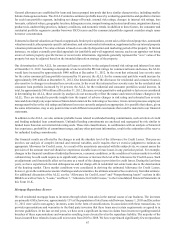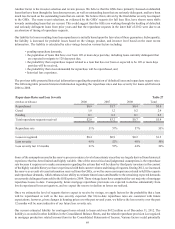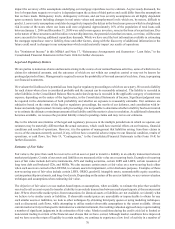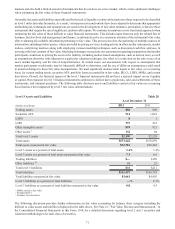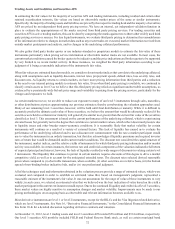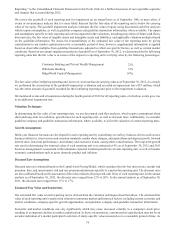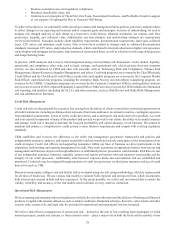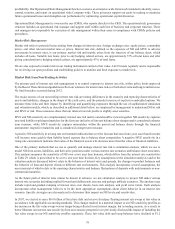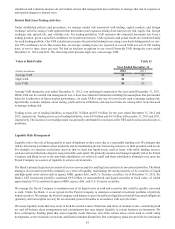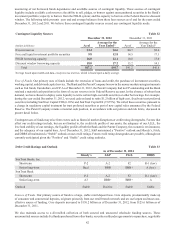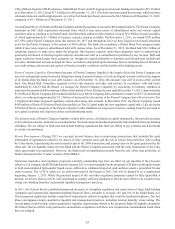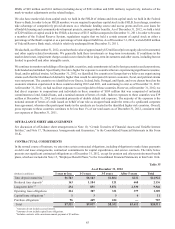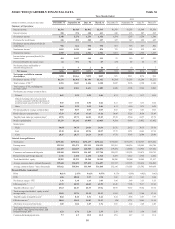SunTrust 2012 Annual Report Download - page 92
Download and view the complete annual report
Please find page 92 of the 2012 SunTrust annual report below. You can navigate through the pages in the report by either clicking on the pages listed below, or by using the keyword search tool below to find specific information within the annual report.76
as of December 31, 2012. For additional information, refer to Note 14, “Income Taxes,” to the Consolidated Financial
Statements in this Form10-K.
Pension Accounting
Several variables affect the annual cost for our retirement programs. The main variables are: (1) size and characteristics of
the eligible population, (2) discount rate, (3) expected long-term rate of return on plan assets, (4) recognition of actual asset
returns, (5) other actuarial assumptions, and (6) healthcare cost for post-retirement benefits. Below is a brief description of
each variable and the effect it has on our pension costs and post-retirement costs. See Note 15, “Employee Benefit Plans,” to
the Consolidated Financial Statements in this Form 10-K for additional information.
Size and Characteristics of the Employee Population
Pension cost is directly related to the number of employees eligible to participate in the plan and other factors including
historical compensation, age, years of employment, and benefit terms. A curtailment of all pension benefit accruals was
effective December 31, 2011. Prior to the pension curtailment, most participants who had 20 or more years of service as of
December 31, 2007 received benefits based on a traditional pension formula with benefits linked to their final average pay
and years of service. Most other participants received a traditional pension for periods prior to 2008 plus a cash balance benefit
based on annual compensation and interest credits earned after 2007.
Discount Rate
The discount rate is used to determine the present value of future benefit obligations. The discount rate for each plan is
determined by matching the expected cash flows of each plan to a yield curve based on long-term, high quality fixed income
debt instruments available as of the measurement date. The discount rate for each plan is reset annually or upon occurrence
of an event that triggers a measurement to reflect current market conditions. If we were to assume a 0.25% increase/decrease
in the discount rate for all retirement and other postretirement plans and keep all other assumptions constant, the benefit cost
would decrease/increase by less than $1 million.
Expected Long-term Rate of Return on Plan Assets
Expected returns on plan assets are computed using long-term rate of return assumptions which are selected after considering
plan investments, historical returns, and potential future returns. Our 2012 pension costs reflect an assumed long-term rate
of return on plan assets of 7.00%.
Any differences between expected and actual returns are included in the unrecognized net actuarial gain or loss amount. We
amortize gains/losses in pension expense when the total unamortized amount exceeds 10% of plan assets or the projected
benefit obligations, whichever is greater. All pension gains or losses are being amortized over participants' average expected
future lifetime, which is approximately 35 years. See Note 15, “Employee Benefit Plans,” to the Consolidated Financial
Statements in this Form 10-K for details on changes in the pension benefit obligation and the fair value of plan assets.
If we were to assume a 0.25% increase/decrease in the expected long-term rate of return for the retirement and other
postretirement plans, holding all other actuarial assumptions constant, the benefit cost would decrease/increase by
approximately $7 million.
Recognition of Actual Asset Returns
Accounting guidance allows for the use of an asset value that smooths investment gains and losses over a period up to five
years. However, we have elected to use a preferable method in determining pension cost. This method uses the actual market
value of the plan assets. Therefore, we will experience more variability in the annual pension cost, as the asset values will be
more volatile than companies who elected to “smooth” their investment experience.
Other Actuarial Assumptions
To estimate the projected benefit obligation, actuarial assumptions are required about factors such as mortality rate, retirement
rate, and disability rate. These factors do not tend to change significantly over time, so the range of assumptions, and their
impact on pension cost, is generally limited. We annually review the assumptions used based on historical and expected future
experience.



